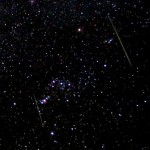The early hours of dawn on May 5th will see the peak of the ηAquariid meteor shower. This is a reliable shower that produces anywhere from 30-80 meteors each hour near peak. Resulting from debris left behind by Comet 1P/Halley this shower approaches the Earth from the direction of the constellation Aquarius. As this constellation is quite low in the sky during the shower the meteors are entering the atmosphere at a low angle, this often results in meteors with long trains crossing much of the sky. A good shower that produces great fireballs.

IMO analyses in recent years, based on data collected between 1984–2001, have shown that ZHRs are generally above 30 between about May 3–10, and that the peak rates appear to be variable on a roughly 12-year timescale. Assuming this Jupiter-influenced cycle is borne-out, the next trough is due around 2014–2016, so ZHRs should be relatively modest in 2013, according to this idea – IMO website
The ηAquariid shower has a broad peak with several weeks of activity either side of the peak. The entire meteor shower lasts from around April 19 to May 28. Any morning from May 3rd to May 10th can be worth watching with rates to around 30 meteors per hour. The peak itself is predicted for 01:00UT on May 6th (15:00HST May 5th), but this shower often produces subpeaks as the Earth passes through clouds of debris left on successive orbits of Halley’s Comet.
The radiant for the ηAquariid shower does not rise until the last few hours of dark, about 2:30am, making this an early morning observing exercise. 2013 does offer decent viewing conditions, with only a slim waning Moon on the day of peak activity and new Moon occurring a few days later on the 10th. Remember, meteor watching can be enjoyed without any special equipment, just a dark sky and a safe place to watch from. Perhaps a good reason to get out under a dark sky? But then, should you ever need a reason to go observing, just go.

